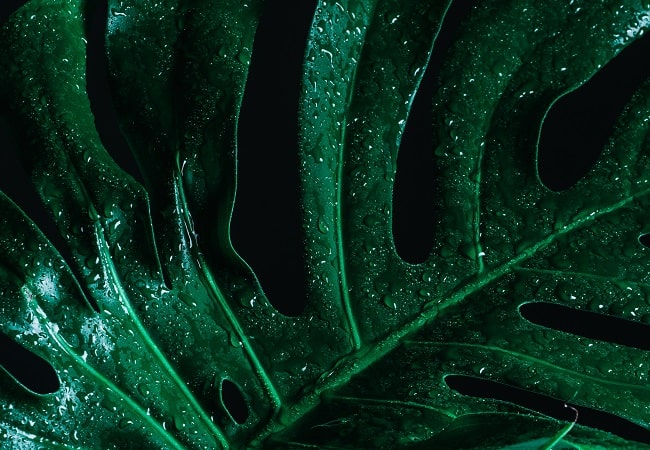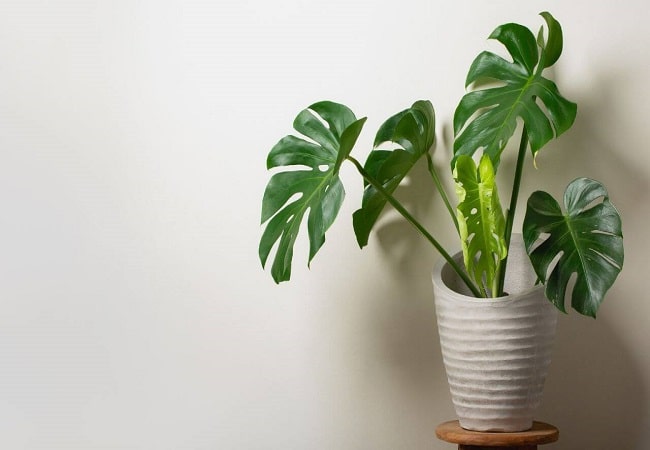Monstera is a vine that grows in the tropical rain forests of Central and South America. They are characterized by their large, leathery leaves. Monsteras are generally easy to care for, but one of the most common questions about them is how to know when they need water. How do i know if my monstera needs water? There are a few telltale signs that your monstera is thirsty. Read on if you want to know when to water your monstera plant. I have all the information you need.
Quick Navigation
How Much Is Water Required for Monstera Plants?

Once every 2 to 3 weeks, water the soil and let it dry out completely. When there’s a lot of light, you should water more often. When there’s no light, you should water less often. Monsteras do best with water that has been filtered through a coffee filter, or that has been left out overnight.
When you water a monstera, ensure the extra water drains out of the bottom of the pot. By watering the plant in this way, which is one of the easiest ways to do it, you can be sure that it gets enough water. Still, you should be careful. Monsters don’t like to sit in water, so make sure to replace any that evaporates. When there is a lot left in the lower saucer, it needs to be emptied.
But a few other things affect how much water a Monstera needs. The most important of these is how much sunlight the plant gets, how humid the air is around it, and how big the plant is. The material of the pot is something to think about, but it shouldn’t make too much of a difference most of the time.
Check Before You Water Your Monstera

Checking the soil before watering any plant can significantly affect how well the plant grows. As you learn more about Monstera, you may find that you don’t need to. But when you start, doing a soil check can make a big difference.
You can check the soil in a few different ways. The easiest way is to test the top inch of soil with your finger to see if it is wet. If it’s still wet, wait a few more days before watering. If it’s bone dry, water it thoroughly right away!
Due to its subjectivity, many individuals find this method unsuitable, so a moisture meter is a great option. Small, ground-penetrating tools. Based on the reading, they include an easy-to-read scale indicating when the entire plant needs watering.
Inspecting Monstera’s soil moisture content before watering can save you time and prevent problems like stem and root rot.
How Do I Know If My Monstera Needs Water Ensure That
One of the most important things you can do for your Monstera is to ensure it is draining correctly. A poorly draining Monstera will not be able to take in enough water. It may even show signs of health decline, such as yellowing leaves or wilted plants.
You can do a few things to help ensure that your Monstera is properly draining.
- First, ensure the pot is large enough for the plant and the root ball is well-covered.
- Second, ensure no rocks or roots are caught in the drainage holes; these can block water flow and lead to over-watering.
- Finally, check the pH level of your soil; if it’s too high or low, this can also affect how well your Monstera drains. If you notice any problems with your Monstera drainage, be sure to take action before it becomes more serious.
The Following Six Monstera Need A Drink of Water
Water is essential for all plants, and Monsteras are no exception. Without enough water, Monsteras will show signs of dehydration, such as yellowing leaves and drooping branches. To determine if your Monstera needs a drink of water, take a look at the following list:
1. The Soil around your Monstera is dry
The main sign that a Monstera needs water is that the soil is dry. Even though it’s important to let the soil dry out between waterings, a Monstera deliciosa shouldn’t live in a dry place. If the soil is too dry, the plant won’t die right away, but it won’t be able to grow as well.
If you test the soil often, you’ll know when your Monstera needs to be watered. This is because every plant and house is different and needs to be watered at different times. Using your finger is the easiest way to do this.
Put your finger about an inch into the soil to see if it’s dry. If it is, you should water the plant. If your Monstera is still wet, don’t water it yet.
2. Your Monstera is leaning to one side
Leaning plants are one of the first signs that a Monstera might be thirsty. If your Monstera is leaning to one side, it’s likely because it doesn’t have enough water. This can happen even if the soil is moist, so always check to see if the plant needs water before doing anything else.
3. The leaves of your Monstera plant are curling
Curling leaves are another sign that a Monstera needs water. When a Monstera needs water, its leaves begin to curl inward, making them look smaller and not as wide.
This is not a permanent problem, and most of the time, it can be fixed by giving the plant a good drink of water and some time. If the soil is dry, check it and give it a good, thorough watering. In a few days, the leaves should go back to how they were before.
If they don’t, this could be a sign that something else is going on. Take the time to check on the plant before you water it again.
4. The leaves are Brown or yellow
If the leaves on your Monstera change color, you might need to worry. A healthy Monstera has waxy, dark green leaves (though younger plants or new leaves may be lighter green).
As Monsteras get older, their older leaves turn yellow and fall off, so it’s normal for them to look a little different. But you have a problem if there are yellow, brown, or dead leaves in more than one place on the plant or if they are mixed in with new leaves.
Suppose you notice any of these signs on your Monstera’s leaves. If that’s the case, they need to be checked out right away by a professional grower or gardener. Most of the time, watering will fix the problem, but if the problem is more serious, you may need to replace the plant (like an over-watering problem).
5. Your Monstera is Drooping or Dying
Your Monstera may also need water if its leaves fall off or droop. If the plant is drooping more than it should, check to see if the soil is dry. If not, if it is dry, give it a good, thorough watering. In a few days, the leaves should go back to how they were before.
If they don’t, this could be a sign that something else is going on. Take the time to check on the plant before you water it again.
If the plant’s leaves fall off and it droops, the soil doesn’t have enough water. Check the soil to see if there are any brown spots. If so, add some organic matter to help the Monstera soak up water and feed it right.
6. The Monstera Doesn’t Have Any Fenestrated Leaves
Monsteras are unique because they don’t have leaves on the bottom of the plant. Instead, the leaves are on top.
This is a characteristic that helps your Monstera stay cooler in hot climates. However, this also makes it difficult for your Monstera to get water. If your Monstera has no fenestrated leaves, it can’t absorb water from the soil easily.
To help your Monstera get more water, add organic matter to the soil and make sure there’s plenty of indirect sunlight to enjoy.
Be Warned: Overwatering Will Also Cause Death to Your Monstera!
Monsteras are very tough plants, so most diseases and parasites don’t hurt them as much as possible. But you will hurt the plant if it gets too much or too little water. But overwatering or underwatering your Monstera plant can cause several problems that are bad for it and you should avoid this.
Stem rot and root rot are two of the most common problems caused by overwatering, and both can be fatal if not found and treated quickly. Fungi can damage the Monstera stem, most often at the point where the stem touches the ground. This condition is called “stem rot.” It will make the stem black or brown and mushy, and there will often be a white or slightly off-white material that looks like a web in the affected area. It might not be easy to treat this condition.
Root rot can be caused by a fungus that grows on the Monstera plant’s roots and stops the plant from getting water and nutrients. This can be just as dangerous. The affected roots will look dark and soft instead of white and solid. Some may even come off the plant when touched and fall to the ground.
The easiest way to prevent these problems is to ensure your Monstera plant doesn’t get too much water. People often say to err on the side of caution and let a plant get completely dry before watering it again rather than risk overwatering it.
Frequently Asked Questions
How Long Can Monstera Go Without Water?
Monstaensis is a plant that can go up to 4 weeks without water. During these weeks, the plant pulls water from the air or the soil. The process of doing this and breaking down complex carbohydrates into glucose and other simple sugars is called photosynthesis. This process uses sunlight to convert carbon dioxide into oxygen.
What Is The Best Way To Water A Monstera?
Watering a Monstera is important for two reasons.
- First, it helps to keep the plant healthy and flourishing.
- Second, it ensures that the plant receives the proper amount of water.
There are a few things to consider when watering a Monstera:
- Ensure to water thoroughly and often enough that the surface of the soil remains moist but not soggy.
- Avoid washing the leaves or submerging the plant in water; this will only cause stress and damage.
- If your Monstera is in a pot, rotate it occasionally so that all sides of the pot get wet.
How Long Does A Monstera Live?
Most monstrosities in the plant kingdom typically have 10-15 years. Monstera is no exception, as they typically live around 30 to 40 years old. This longevity is due largely to the fact that monsteras do not require sunlight or water like other plants and instead get their energy from a symbiotic relationship with a fungus.
Where Should I Place My Monstera?
The best location for a Monstera would depend on various factors, including the climate and light in the room. A Monstera may prefer partial or complete shade, so placing it in an area that receives less direct sunlight might be best. Additionally, a Monstera may prefer a moist environment, so adding humidity levels by using a humidifier may be beneficial.
Final Touch
Care for Monstera is hard to start. Not always is it best to water plants on a schedule. Monstera deliciosa may not always need watering once a week, so pay attention to what it needs. Most plants can tell us what they want and how they feel. If a Monstera shows any of the above signs, you must check its soil immediately.
Checking how much water is in the soil can show a problem. If you care for your Monstera, it won’t get sick or die. Even though they seem happy, they have a problem that won’t become clear until it’s too late. As you care for a Monstera, you can learn to trust your gut more. This takes some time to learn, but once you do, it will be much easier to water a Monstera deliciosa.

My name is Md Robiul Islam and I’m a plant enthusiast. I like to have a garden and research different plants. I also have an interest in environmental science and would like to work in that field in the future.


